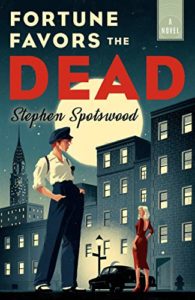Sunday night was a church night. So were Wednesday nights and Sunday mornings, but Sunday nights were my favorite. Because Sunday night was murder night.
After service, while my parents mingled with the rest of the congregation in the parking lot, I grabbed the car keys from my father, shut myself in our aging Buick, and turned the dial to an AM station out of Philadelphia. These days that station is a toxic stew of right-wing talk radio. But back then, for two hours each Sunday evening, that station would air old radio shows from the 30s, 40s, and 50s. Sometimes comedy, occasionally drama, but most often murder.
So while my parents chatted and my deacon father waited for everyone to leave so he could lock up, I let voices from half a century before weave tales of suspense, crime, and the heroes and villains who rubbed shoulders in the shadows.
While I’m sure my parents would have preferred a child who was more interested in the content of the Sunday evening sermon rather than its brevity, they certainly didn’t dissuade me. They even found a mail-order company that sold cassette tapes of those old radio dramas. I was no longer beholden to the whim of the AM station’s producers. I could pick and choose. More often than not I chose the sound of ominous footsteps in the hall, doors creaking open, screams echoing in the night.
In recent years audio-driven entertainment has once again carved out a corner of my internal landscape. My phone is filled with podcasts, episodic audio dramas like Welcome to Nightvale, and I just finished the Audible adaptation of The Sandman. And as theatre artists around the world wait for their industry to reopen, many are exploring the world of audio drama as a way to make work that’s inexpensive, easy to distribute, and whose limits are defined only by the listener’s imagination.
I couldn’t be more excited to see what they create.
In the meantime, here are a few of the discoveries I made as a child, sitting in a darkened car, waiting and listening.
The Shadow (1937-1954)
“Who knows what evil lurks in the hearts of men? The Shadow knows!”
Wealthy man about town Lamont Cranston fights a one-man war against crime as the caped vigilante, the Shadow. If the set-up sounds familiar that’s because The Shadow, along with Zorro, provided the foundation for Batman. But while Batman’s powers are driven solely by rigorous training and his colossal wealth, Cranston has developed a set of strange mental abilities, including telepathy, hypnosis, and the ability to “cloud men’s minds” so they cannot see him. With the title character voiced by Orson Welles, The Shadow was must-listen entertainment during the 1940s and, likely thanks to the many vigilante heroes he inspired, has lingered in the public consciousness long after his pulp companions have faded.
The New Adventures of Sherlock Holmes (1939-1950)
There is something about the heady mix of adventure and mystery with just a dash of horror that made Sherlock Holmes ripe for radio. Each week a representative of the show’s sponsor joined Dr. Watson in his study and was told a new, thrilling tale of the doctor’s adventures with the famous detective. Some were based on Arthur Conan Doyle’s original stories, while many were written specifically for radio. For most of its run it starred Basil Rathbone as Holmes and Nigel Bruce as Watson, who went on to star in several Holmes movies together, and whose chemistry kept listeners coming back for more than a decade.
Inner Sanctum (1941-1952)
An organ plays, a door creaks open, and a man with a baritone voice says, “Oh, hello there. I’m so glad you came tonight” in a way that makes you wonder if it would have been safer to stay home. With one foot in mystery and the other placed firmly in horror, Inner Sanctum was an anthology series of strange and chilling tales that guest starred film greats like Bela Lugosi, Orson Welles, and Claude Rains.
The Whistler (1942-1955)
A crime anthology, The Whistler got its name from its sinister-voiced narrator, with each episode opening to the sound of footsteps and whistling. Each week, he would lead the audience through a tale of a person who, for reasons selfish or righteous, sets out to commit a flawless crime. Irony was a chief ingredient in The Whistler, so each week the criminal is brought low by fate. Apparently it was a flavor audiences enjoyed, because the show became one of the longest-running series and saw out the golden age of radio.
Perry Mason (1943-1955)
Thanks to the HBO series, a whole new generation is discovering Earle Stanley Gardener’s hero of the unfairly accused. But before he made his way to television, the unconventional defense attorney was the star of a crime serial with stories unfolding daily in ten-minute increments. This version of the character has more in common with the HBO version—more than willing to get his hands dirty—than the stately courtroom figure of Gardener’s novels and Raymond Burr’s TV persona.
Candy Matson (1949-1951)
There weren’t many leading ladies during the golden age of radio, at least not with P.I. tacked onto their name. But Candy Matson proved that women could handle the hardboiled lingo just as well as their male counterparts. A former model turned detective in San Francisco, Candy was smart and witty, with a willingness to use people’s assumptions to her advantage. Unfortunately, Candy remained a West Coast program and never got the national exposure she deserved.
Dragnet (1949-1957)
“The story you are about to hear is true. Only the names have been changed to protect the innocent.” Before Law and Order had the chance to rip anything from the headlines, Dragnet was using real-life crimes to inspire the adventures of Sgt. Joe Friday, a member of the Los Angeles police department. Dragnet was proof-of-concept that there was an audience for modern police procedurals that leaned away from melodrama and toward the nuts and bolts of crime-solving.
Yours Truly, Johnny Dollar (1949-1962)
Billed as “the man with the action-packed expense account,” Johnny Dollar was a special investigator for an insurance company who was sent to nose into suspicious deaths, possible frauds, missing persons, and any claim his bosses didn’t want to pay out. Each episode was structured around Johnny tallying items in his expense report. Standing firmly on the wisecracking side of the hardboiled divide, Johnny Dollar was for listeners who liked their detectives with tongue firmly in cheek.
The New Adventures of Nero Wolfe (1950-1951)
Rex Stout’s creation appeared in a number of programs during radio’s heyday, but it was The New Adventures of Nero Wolfe starring Sydney Greenstreet that made the caustic, finicky detective a radio star. The show, like Stout’s novels, placed voice and character over plot. And with quick-talking legman Archie Goodwin acting as the foil for Wolfe, there was plenty of character to go around.
CBS Radio Mystery Theatre (1974-1982)
Created by Inner Sanctum originator Himan Brown, Radio Mystery Theatre was designed to appeal to people old enough to be nostalgic for radio’s golden age, but ended up drawing in a much wider audience. Another anthology series, CBSRMT ran regularly on CBS’s affiliates and went well beyond the “Mystery” in its title to encompass a host of other genres. While it never quite managed to transcend its mid-century roots, the show’s positives include clear recordings that are easily available online and episodes featuring actors that modern audiences can still see on screen today.
***
While many recordings have been lost to time, episodes from all of these title are available online, either on old time radio sites, through streaming apps, or simply on YouTube.
Happy listening.


















